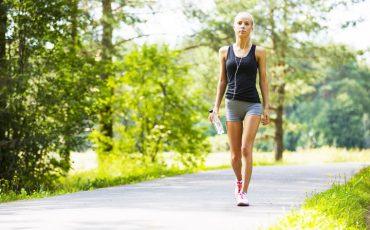With good shoes on your feet, you’re nearly ready to hit the road. Although great shoes are the key ingredient, carefully considered clothes will make your workouts more comfortable.
Next to shoes, socks are your best friend. Avoid cotton; synthetic fibers are better at drawing moisture away from your skin and they don’t end up soggy. Wet socks rub and cause blisters, besides being uncomfortable. Consider some of the newer and finer wool socks; they’ve come a long way. Look for snugly fitting socks with as few seams to chafe as possible. For some blister-prone people, wearing two thin pairs of socks can eliminate rubbing. Consider trying on your socks of choice with your shoes when you shop because thicker socks may alter the fit you need.
Tops, whether short- or long-sleeved, should be comfortable and allow you to swing your arms freely. They can either be loose or snug, but avoid bulky seams. The best clothing is made of high-tech synthetic materials that breathe and wick moisture away from your skin, keeping you cooler in hot weather and warmer in cold. Although they can be more expensive than that old T-shirt in your drawer, I’d bet my bottom dollar that you will love any lightweight technical shirt you get that is made for activity and sweating. If you aren’t prepared to invest the money, your next best bet is a natural fiber, such as cotton, especially for indoor workouts where the elements aren’t a big factor.
 Bottoms, from sweats to shorts, can be loose fitting without bulky seams be – tween your thighs to irritate or chafe, or skin tight, depending on your personal comfort level. Long tights in the winter and thigh-length tights in the summer protect and support well. Here, too, high-performance wicking fabrics are available, as are blends with Lycra. Personal preference and budget play the largest role in your decision.
Bottoms, from sweats to shorts, can be loose fitting without bulky seams be – tween your thighs to irritate or chafe, or skin tight, depending on your personal comfort level. Long tights in the winter and thigh-length tights in the summer protect and support well. Here, too, high-performance wicking fabrics are available, as are blends with Lycra. Personal preference and budget play the largest role in your decision.
Headgear is important to protect you from the sun in the summer and retain body heat in the winter. If you’re worried about sun, consider a cap with a drape in the back to protect your neck or a hat with a wide brim. In the winter, cover up with wind- or waterproof shells and, if in a really cold climate, shell pants, preferably those that are breathable to allow your sweat to evaporate. Layers work best—not only to trap your body heat, but to peel off as you heat up or put on as you cool down. I can’t begin to explain the choices in jackets, but I will tell you that the windbreaker has changed a lot. There are all levels of windproof, water-resistant, and waterproof jackets with hoods or not, with full or half zippers, with pockets or not, or with underarm zippers or not. Check out local specialty running stores (they carry lightweight outerwear good for walking or running), sporting goods stores, or even an outdoor specialty store. Although outdoor specialty stores may cater to backpackers and hikers, the outerwear (as well as gloves and headgear) crosses over well. Hands, too, need protection in the cold. For cool days, lightweight glove liners are fine. Otherwise look for thermal mittens or gloves or those made of moisture-wicking materials. All those technical fibers, including those that repel water or stop wind, are also available in gloves and mittens. Consider these items an investment in your comfort. If you’re comfortable, you’ll be much more likely to keep up your walking program.

Leave a Reply